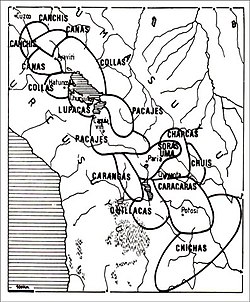Colla Kingdom | |||||||||
|---|---|---|---|---|---|---|---|---|---|
| c. 1150–c. 1463 | |||||||||
 The Colla culture area, in the northern Titicaca Basin, along with other altiplano polities. | |||||||||
| Capital | Hatunqulla (Urcosuyu), Azángaro (Umasuyu) | ||||||||
| Common languages | Quechua, Aymara | ||||||||
| Other languages | Puquina, Uru | ||||||||
| Government | Diarchy | ||||||||
| Historical era | Late Intermediate | ||||||||
• Established | c. 1150 | ||||||||
• Conquered by the Inca Empire under Pachacuti | c. 1463 | ||||||||
• Revolt crushed by Topa Inca Yupanqui | c. 1483 | ||||||||
| |||||||||

The Colla, Qolla or Qulla Kingdom was established in the northwestern basin of the Titicaca, one of the Aymara kingdoms that occupied part of the Collao plateau after the fall of Tiwanaku.[1] In the mid-15th century the Collas possessed a vast territory, one of the largest of the Aymara kingdoms, which at the time the 9th Sapan Inka Pachakutiq Yupanqui Qhapaq the Intipchurin ("son of the sun"), conquered along with other political entities in the region.
The Inca empire named the Qullasuyo or Colla Region towards a larger region than the original Colla Kingdom, as the Aymara kingdoms with strong cultural ties between them were called by the Incas with the collective term of "Colla" as it was for them the most significant of them all.[2]
- ^ Grasso, Dick Edgar Ibarra (1955). "Esquema de la Arqueología Boliviana". Zeitschrift für Ethnologie. 80 (2): 192–199. JSTOR 25840346.
- ^ Soriano, Waldemar Espinoza (1987). "Migraciones internas en el reino colla tejedores, plumereros y alfareros del Estado imperial Inca". Chungara: Revista de Antropología Chilena (19): 243–289. JSTOR 27801933. ProQuest 1292959046.